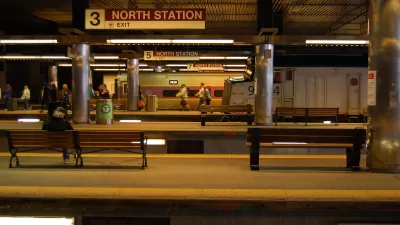The agency is pairing with nonprofit partners to provide on-site services and resources to riders and boosting fare enforcement without police involvement.

Minnesota’s Metro Transit agency is implementing a public safety program aimed at reducing open drug use on transit vehicles, which riders cite as a top reason for feeling unsafe, as well as enforcing fare collection, writes Jared Brey in Governing.
As Brey explains, “Pandemic-era ridership losses reduced social pressure on buses and trains, and led to increased smoking and drug use not just in the Twin Cities but all over the U.S.” To improve safety, Metro Transit launched its Transit Service Intervention Project, which partners with nonprofit service providers to “offer everything from on-the-spot health care from registered nurses to housing assistance to mental health and addiction services.”
A second phase of the plan, the Transit Rider Investment Program, “involves Metro personnel — not police — enforcing payment on transit vehicles by handing out fines and citations to fare-jumpers.”
Sam Rockwell, executive director of Move Minnesota, says the programs could help improve rider perception and increase ridership because, “More than anything else, full trains and buses are what will keep the system feeling safe.”
FULL STORY: Minnesota's Top Transit Agency Tries New Approaches to Public Safety

Study: Maui’s Plan to Convert Vacation Rentals to Long-Term Housing Could Cause Nearly $1 Billion Economic Loss
The plan would reduce visitor accommodation by 25,% resulting in 1,900 jobs lost.

North Texas Transit Leaders Tout Benefits of TOD for Growing Region
At a summit focused on transit-oriented development, policymakers discussed how North Texas’ expanded light rail system can serve as a tool for economic growth.

Why Should We Subsidize Public Transportation?
Many public transit agencies face financial stress due to rising costs, declining fare revenue, and declining subsidies. Transit advocates must provide a strong business case for increasing public transit funding.

How to Make US Trains Faster
Changes to boarding platforms and a switch to electric trains could improve U.S. passenger rail service without the added cost of high-speed rail.

Columbia’s Revitalized ‘Loop’ Is a Hub for Local Entrepreneurs
A focus on small businesses is helping a commercial corridor in Columbia, Missouri thrive.

Invasive Insect Threatens Minnesota’s Ash Forests
The Emerald Ash Borer is a rapidly spreading invasive pest threatening Minnesota’s ash trees, and homeowners are encouraged to plant diverse replacement species, avoid moving ash firewood, and monitor for signs of infestation.
Urban Design for Planners 1: Software Tools
This six-course series explores essential urban design concepts using open source software and equips planners with the tools they need to participate fully in the urban design process.
Planning for Universal Design
Learn the tools for implementing Universal Design in planning regulations.
City of Santa Clarita
Ascent Environmental
Institute for Housing and Urban Development Studies (IHS)
City of Grandview
Harvard GSD Executive Education
Toledo-Lucas County Plan Commissions
Salt Lake City
NYU Wagner Graduate School of Public Service





























